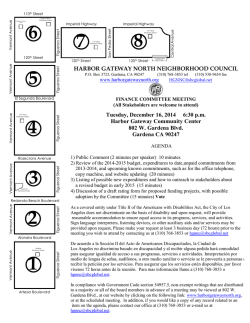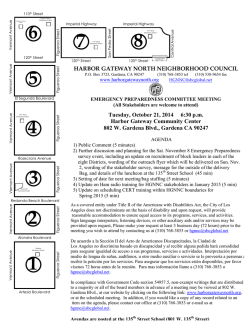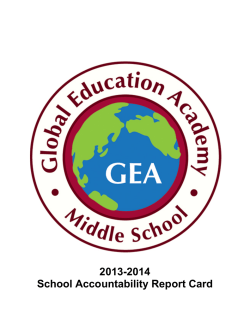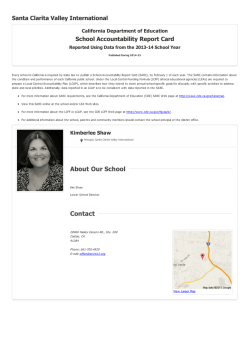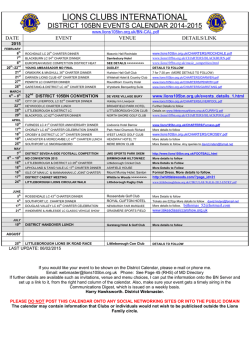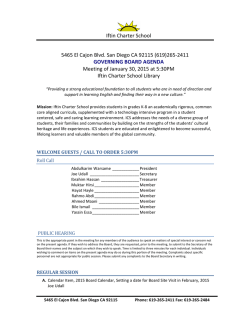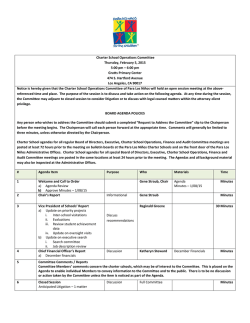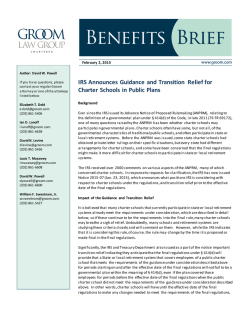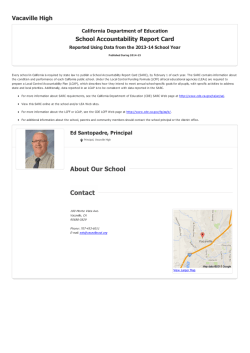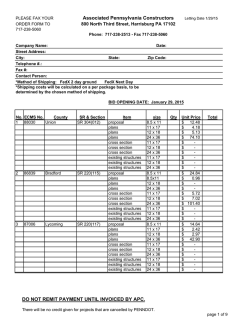
Download SARC Report - Environmental Charter Middle School
California Department of Education School Accountability Report Card Reported Using Data from the 2013–14 School Year Published During 2014–15 For Environmental Charter Middle School Gardena Address: 812 W. 165th Place, Gardena 90247 Principal: Debbie Dempsey Phone: 310-425-1605 Grade Span: 6-8 Every school in California is required by state law to publish a School Accountability Report Card (SARC), by February 1 of each year. The SARC contains information about the condition and performance of each California public school. Under the Local Control Funding Formula (LCFF) all local educational agencies (LEAs) are required to prepare a Local Control Accountability Plan (LCAP), which describes how they intend to meet annual school-specific goals for all pupils, with specific activities to address state and local priorities. Additionally, data reported in an LCAP is to be consistent with data reported in the SARC. ➢ For more information about SARC requirements, see the California Department of Education (CDE) SARC Web page at http://www.cde.ca.gov/ta/ac/sa/. ➢ View this SARC online at the school and/or LEA Web sites. ➢ For more information about the LCFF or LCAP, see the CDE LCFF Web page at http://www.cde.ca.gov/fg/aa/lc/. ➢ For additional information about the school, parents and community members should contact the school principal or the district office. Environmental Charter Middle School - Gardena Report Year: 2013-14 About This School District Contact Information – Most Recent Year District Name Phone Number Superintendent E-mail Address Web Site Environmental Charter Middle School - Gardena 310-425-1605 Alison Diaz [email protected] www.ecmsgardena.org School Contact Information – Most Recent Year School Name Street City, State, Zip Phone Number Principal E-mail Address Web Site County-District-School (CDS) Code Environmental Charter Middle School - Gardena th 812 W. 165 Place Gardena, CA 90247 310-425-1605 Debbie Dempsey [email protected] www.ecmsgardena.org 19101990121772 2 Environmental Charter Middle School - Gardena Report Year: 2013-14 School Description and Mission Statement – Most Recent Year Environmental Charter Middle School offers students a small, caring school environment that supports students’ transition from elementary school, prepares them for success in a college preparatory high school and empowers them to become leaders in their community and world. EMCMS is part of the Environmental Charter Schools network of free, public schools in south Los Angeles. Our mission is to create and deliver vibrant, innovative, interdisciplinary learning opportunities using the environment to engage students and connect them to the wider world. ECMS has operated since 2010, locating temporarily in Inglewood, and moving to its permanent facility in Gardena/Harbor-Gateway in 2013. Our school is small, with only 360 students in grade 6-8, and we th value a strong school community. Our 6 grade students have two core teachers – one for math and th science, and one for English and history. These core teachers loop to 7 grade with their students, th promoting strong relationships between teachers and families. To prepare them for high school, our 8 grade students have four core teachers. Students also take specialty subject courses to support their academic, social and physical development including College Readiness, Games and Movements (physical education), Arts and Handwork, and Green Ambassadors, an environmental education and leadership sequence. We also use the Tribes Learning Community process to teach students the social and emotional skills they need to be resilient and successful in a rapidly changing world. Our curriculum is inter-disciplinary and project-based. Each trimester students participate in an interdisciplinary benchmark project, integrating knowledge and skills from English, history, math and science into a performance assessment, which allows students to demonstrate their mastery of standards at a higher level than traditional tests. They must apply their learning and use cross-curricular skills and concepts in concert with one another to solve problems in real-world and historical settings. For example, th when 8 grade students were studying buoyancy, the American Revolution and time/distance/rate, they built cardboard boats large enough to support a student, calculated their buoyancy, determined their cargo, raced the laden boats and calculated their rate of travel, and then wrote about their experiences th from the point of view of a ship’s captain in 18 Century New England. The tasks are challenging and result in a deep understanding of skills and concepts. ECMS also values partnerships with the large community. Our After School program partners with the Gardena/Carson YMCA, enabling students to compete in a basketball league and swim after school. Our th 7 grade students spent the night at the Ocean Institute in Dana Point, after a day of marine research and fish dissection. In 2012-13 we were fortunate to partner with IKEA, who interior designed and furnished a classroom and library space for us. State Farm funded raised garden beds, fruit trees and other sustainable projects. Kaboom! and CarMax provided equipment, man-power and inspiration for a oneday playground build. ECMS is open to any middle school student regardless of where they live. Applications are available on our website: www.ecmsgardena.org. Student Enrollment by Grade Level (School Year 2013–14) Grade Level Grade 6 Grade 7 Grade 8 Total Enrollment Number of Students 115 104 123 342 3 Environmental Charter Middle School - Gardena Report Year: 2013-14 Student Enrollment by Student Group (School Year 2013–14) Group Black or African American American Indian or Alaska Native Asian Filipino Hispanic or Latino Native Hawaiian or Pacific Islander White Two or More Races Socioeconomically Disadvantaged English Learners Students with Disabilities Percent of Total Enrollment 22.5% 0% 1.5% 1.2% 71.6% 0% 1.2% 1.8% 92.4% 10.2% 8.8% A. Conditions of Learning State Priority: Basic The SARC provides the following information relevant to the Basic State Priority (Priority 1): Degree to which teachers are appropriately assigned and fully credentialed in the subject area and for the pupils they are teaching; Pupils have access to standards-aligned instructional materials; and School facilities are maintained in good repair. Teacher Credentials Teachers With Full Credential Without Full Credential Teaching Outside Subject Area of Competence (with full credential) School 2012–13 13 0 District 2013–14 13 0 School 2014–15 18 0 District 2014–15 18 0 1 1 0 0 Teacher Misassignments and Vacant Teacher Positions Indicator Misassignments of Teachers of English Learners Total Teacher Misassignments* Vacant Teacher Positions 2012–13 1 2 0 2013–14 1 4 0 2014–15 0 0 0 Note: “Misassignments” refers to the number of positions filled by teachers who lack legal authorization to teach that grade level, subject area, student group, etc. * Total Teacher Misassignments includes the number of Misassignments of Teachers of English Learners. 4 Environmental Charter Middle School - Gardena Report Year: 2013-14 Core Academic Classes Taught by Highly Qualified Teachers (School Year 2013–14) Location of Classes This School All Schools in District High-Poverty Schools in District Low-Poverty Schools in District Percent of Classes In Core Academic Subjects Taught by Highly Qualified Teachers 100% 100% 100% 0% Percent of Classes In Core Academic Subjects Not Taught by Highly Qualified Teachers 0% 0% 0% 0% Note: High-poverty schools are defined as those schools with student eligibility of approximately 40 percent or more in the free and reduced price meals program. Low-poverty schools are those with student eligibility of approximately 39 percent or less in the free and reduced price meals program. Quality, Currency, Availability of Textbooks and Instructional Materials – Most Recent Year Year and month in which data were collected: August 2014 Subject Reading/Language Arts Mathematics Science History-Social Science Textbooks and Instructional Materials/year of Adoption Write Source (Houghton Mifflin Harcourt), Foundations English Language Arts (Kaplan), Language! (Sopris West Educational Services) Holt California Mathematics (Holt), Foundation Mathematics (Kaplan), Connected Math (Pearson), ST Math (Mind Research), Go Math (Houghton Mifflin Harcourt) Focus on Earth Science (Prentice Hall), Focus on Life Science (Prentice Hall), Focus on Physics (Prentice Hall), Education and the Environment Curriculum (Office of Education and the Environment) Ancient Civilizations (Prentice Hall), Medieval and Early Modern Times (Prentice Hall), American History of our Nation (Prentice Hall), Education and the Environment Curriculum (Office of Education and the Environment) From Most Recent Adoption? Percent Students Lacking Own Assigned Copy Yes 0% Yes 0% Yes 0% Yes 0% 5 Environmental Charter Middle School - Gardena Report Year: 2013-14 Foreign Language N/A N/A 0 Health N/A N/A 0 Our Handwork class is aligned with our core curriculum. Handwork teachers do not use textbooks. They create their curriculum in collaboration with core content teachers. N/A 0 N/A N/A N/A Visual and Performing Arts Science Laboratory Equipment (grades 9-12) School Facility Conditions and Planned Improvements – Most Recent Year ECMS-Gardena campus is comprised of three separate buildings, a playground area, and a parking lot which are enclosed with a gated fence. The education building was renovated from an existing two-story building, and now contains 14 classrooms on two floors. The classrooms are bright and open with large windows and skylights. Four classrooms on the ground floor have garage doors to provide outdoor access for environmental-focused project-based learning. Two classrooms on the second floor open to patios that allow students to create and maintain a hydroponic watering system and long-term projects. The center atrium was planned to support a large tree in the center, continuing the school-wide focus on the environment. The one-story office complex contains restrooms for staff and students, and office space for the main office. The third building is a two-story Baptist church that was built in 1950, and was renovated to 2 provide an additional 8,000 ft for classrooms and office space, including a large conference room on the nd 2 floor and office space for Charter Management Office support staff. The second floor is accessed by a handicapped-accessible wheelchair lift, which provides space for large group meetings of students, parents, and community partnerships. The facilities site inspection was conducted by Denise Fay, Facilities Planning Specialist for Facilities Planning Services at the Los Angeles County Office of Education on December 3, 2013. A copy of the report is included in Appendix V. The report indicated compliance in all areas, with one recommendation to secure book cabinets to the wall in one classroom. There were no required corrections or recommendations. 6 Environmental Charter Middle School - Gardena Report Year: 2013-14 School Facility Good Repair Status – Most Recent Year Using the most recent FIT data (or equivalent), provide the following: Determination of repair status for systems listed Description of any needed maintenance to ensure good repair The year and month in which the data were collected The overall rating System Inspected Systems: Gas Leaks, Mechanical/HVAC, Sewer Interior: Interior Surfaces Cleanliness: Overall Cleanliness, Pest/ Vermin Infestation Electrical: Electrical Restrooms/Fountains: Restrooms, Sinks/ Fountains Safety: Fire Safety, Hazardous Materials Structural: Structural Damage, Roofs External: Playground/School Grounds, Windows/ Doors/Gates/Fences Repair Needed and Action Taken or Planned 12/03/2013 Inspection completed by Denise Fay, Facilities Planning Specialist, LACOE Good Fair Poor x Compliant; no action required x x Compliant; no action required Compliant; no action required x x Compliant; no action required x Anchor IKEA cabinets to wall in classroom 3 x Compliant; no action required Compliant; no action required x Compliant; no action required Overall Facility Rate – Most Recent Year Overall Rating Exemplary x Good Fair Poor B. Pupil Outcomes State Priority: Pupil Achievement The SARC provides the following information relevant to the Pupil Achievement State Priority (Priority 4): Statewide assessments (i.e., California Assessment of Student Performance and Progress and its successor the Standardized Testing and Reporting Program); The Academic Performance Index; and The percentage of pupils who have successfully completed courses that satisfy the requirements for entrance to the University of California and the California State University, or career technical education sequences or programs of study. 7 Environmental Charter Middle School - Gardena Report Year: 2013-14 California Assessment of Student Performance and Progress/ Standardized Testing and Reporting Results for All Students in Science – Three-Year Comparison Subject Science (grades 5, 8, and 10) Percent of Students Scoring at Proficient or Advanced (meeting or exceeding the state standards) School District State 2011–12 2012–13 2013–14 2011–12 2012–13 2013–14 2011–12 2012–13 2013–14 0 67% 61% 30% 32% 37% 60% 66% 67% Note: Science assessments include California Standards Tests (CSTs), California Modified Assessment (CMA), and California Alternate Performance Assessment (CAPA). Note: Scores are not shown when the number of students tested is ten or less, either because the number of students in this category is too small for statistical accuracy or to protect student privacy. California Assessment of Student Performance and Progress Results by Student Group in Science (School Year 2013–14) Group Percent of Students Scoring at Proficient or Advanced All Students in the LEA All Students at the School Male Female Black or African American American Indian or Alaska Native Asian Filipino Hispanic or Latino Native Hawaiian or Pacific Islander White Two or More Races Socioeconomically Disadvantaged English Learners Students with Disabilities Students Receiving Migrant Education Services 61% 61% 73% 61% 76% N/A N/A N/A 64% N/A N/A N/A 66% 31% N/A N/A Note: Science assessments include CSTs, CMA, and CAPA in grades 5, 8, and 10. Note: Scores are not shown when the number of students tested is ten or less, either because the number of students in this category is too small for statistical accuracy or to protect student privacy. 8 Environmental Charter Middle School - Gardena Report Year: 2013-14 Standardized Testing and Reporting Results for All Students – Three-Year Comparison Percent of Students Scoring at Proficient or Advanced (meeting or exceeding the state standards) School District State 2010–11 2011–12 2012–13 2010–11 2011–12 2012–13 2010–11 2011–12 2012–13 Subject English-Language Arts Mathematics History-Social Science 47% 55% 51% 30% 33% 35% 54% 56% 55% 27% 28% 23% 19% 23% 25% 49% 50% 50% N/A N/A 64% 19% 24% 27% 48% 49% 49% Note: STAR Program was last administered in 2012–13. Percentages are not calculated when the number of students tested is ten or less, either because the number of students in this category is too small for statistical accuracy or to protect student privacy. Academic Performance Index Ranks – Three-Year Comparison API Rank Statewide Similar Schools 2010–11 2 N/A 2011–12 3 5 2012–13 4 4 Note: For 2014 and subsequent years, the statewide and similar schools ranks will no longer be produced. Academic Performance Index Growth by Student Group – Three-Year Comparison Group All Students at the School Black or African American American Indian or Alaska N/Ative Asian Filipino Hispanic or Latino Native Hawaiian or Pacific Islander White Two or More Races Socioeconomically Disadvantaged English Learners Students with Disabilities Actual API Change 2010–11 B N/A N/A N/A N/A N/A N/A N/A N/A N/A N/A N/A Actual API Change 2011–12 16 N/A N/A N/A N/A 20 N/A N/A N/A 1 N/A N/A Actual API Change 2012–13 11 N/A N/A N/A N/A 6 N/A N/A N/A 5 -69 N/A Note: "N/D” means that no data were available to the CDE or LEA to report. “B” means the school did not have a valid API Base and there is no Growth or target information. “C” means the school had significant demographic changes and there is no Growth or target information. 9 Environmental Charter Middle School - Gardena Report Year: 2013-14 Career Technical Education Programs (School Year 2013–14) ECMS does not offer a career technical education program, nor do any of the middle-school level courses meet the requirements for CTE. Career Technical Education Participation (School Year 2013–14) Measure CTE Program Participation N/A Number of pupils participating in CTE Percent of pupils completing a CTE program and earning a high school diploma Percent of CTE courses sequenced or articulated between the school and institutions of postsecondary education N/A N/A Courses for University of California and/or California State University Admission UC/CSU Course Measure 2013–14 Students Enrolled in Courses Required for UC/CSU Admission 2012–13 Graduates Who Completed All Courses Required for UC/CSU Admission Percent N/A N/A State Priority: Other Pupil Outcomes The SARC provides the following information relevant to the Other Pupil Outcomes State Priority (Priority 8): Pupil outcomes in the subject areas of English, mathematics, and physical education. California Physical Fitness Test Results (School Year 2013–14) Grade Level 5 7 9 Percent of Students Meeting Four of Six Fitness Standards N/A 25.5% N/A Percent of Students Meeting Five of Six Fitness Standards N/A 19.4% N/A Percent of Students Meeting Six of Six Fitness Standards N/A 15.3% N/A Note: Percentages are not calculated when the number of students tested is ten or less, either because the number of students in this category is too small for statistical accuracy or to protect student privacy. 10 Environmental Charter Middle School - Gardena Report Year: 2013-14 Engagement State Priority: Parental Involvement The SARC provides the following information relevant to the Parental Involvement State Priority (Priority 3): Efforts the school district makes to seek parent input in making decisions for the school district and each school site. Opportunities for Parental Involvement – Most Recent Year Since ECMS was chartered to serve the Gardena community, but was initially located in Inglewood, parent participation was challenging for many of our parents did not live nearby the school site. In the spring of 2013 we moved to our permanent location in Gardena, and many of our Inglewood-based families remained actively enrolled in our school. When parents first enroll their students, we share with them a range of ways they can participate at ECMS. Every ECMS parent signs our parent/school contract, which is explained to them at a parent orientation meeting in the summer prior to the start of school. Sessions are provided in English and Spanish, as are all the printed materials. In this contract, parents commit to send their child to school consistently, to create a space for homework completion, to sign weekly reading logs and progress reports, to attend parent-teacher conferences each trimester, to ensure students get enough sleep and don’t’ bring sugary food to campus, and to read communication from school. The school commits to provide a safe and clean learning environment, to monitor student dress, to assign meaningful homework, to update grades weekly, to communicate frequently via email, website and a Friday newsletter, to provide remediation and enrichment opportunities, to provide healthy food and snacks and to provide explanations for policies and opportunities for parents to give feedback and participate in policy development, Parents meet with teachers three times each year and participation rates are extremely high. Parents are th also encouraged to attend students’ presentations and performances. The 6 grade Olympic games and th the 7 grade medieval Faire were both well attended by parents, as are the appreciation assemblies, after school celebrations, culture fair, and honor breakfasts. Parent education workshops are offered monthly on topics including adolescent sexual development, preparing healthy meals, and preventing substance abuse. Food and free babysitting was offered to make it easier for parents to attend. ECMS has an elected parent council which includes representatives from each grade level. The Parent Council members also participate on our school site council and help develop our Single Plan for Student Achievement, our Wellness Plan, and the LCAP. Many parents volunteer to help ECMS with outreach, posting and passing out fliers, and helping present during parent information meetings. Parents also participated in our Kaboom! playground build and help to chaperone field trips throughout the year. 11 Environmental Charter Middle School - Gardena Report Year: 2013-14 State Priority: Pupil Engagement The SARC provides the following information relevant to the Pupil Engagement State Priority (Priority 5): High school dropout rates; and High school graduation rates. Dropout Rate and Graduation Rate (Four-Year Cohort Rate) Indicator Dropout Rate Graduation Rate School District State 2010–11 2011–12 2012–13 2010–11 2011–12 2012–13 2010–11 2011–12 2012–13 N/A N/A N/A N/A N/A N/A N/A N/A N/A N/A N/A N/A N/A N/A N/A N/A N/A N/A Completion of High School Graduation Requirements – Graduating Class of 2013 Group All Students Black or African American American Indian or Alaska Native Asian Filipino Hispanic or Latino Native Hawaiian or Pacific Islander White Two or More Races Socioeconomically Disadvantaged English Learners Students with Disabilities School N/A N/A N/A N/A N/A N/A N/A N/A N/A N/A N/A N/A District N/A N/A N/A N/A N/A N/A N/A N/A N/A N/A N/A N/A State N/A N/A N/A N/A N/A N/A N/A N/A N/A N/A N/A N/A State Priority: School Climate The SARC provides the following information relevant to the School Climate State Priority (Priority 6): Pupil suspension rates; Pupil expulsion rates; and Other local measures on the sense of safety. Suspensions and Expulsions Rate Suspensions Expulsions School District 2011–12 2012–13 2013–14 2011–12 2012–13 2013–14 15 8 (8%) 16 (5%) 8 (8%) 16 (5%) 15 (4%) (4%) 2 (2%) 1 (0.4%) 0 2 (2%) 1 (0.4%) 0 State 2011–12 2012–13 2013–14 5.7% 5.1% 4.4% 0.1% 0.1% 0/1% 12 Environmental Charter Middle School - Gardena Report Year: 2013-14 School Safety Plan – Most Recent Year Safety is a priority at EMCS, as we believe students cannot learn when they feel unsafe. Based on climate surveys, most parents and students strongly agree that ECMS is a safe community, and safety is one reason parents frequently cite for enrolling their students and ECMS. Student safety is supported first through our Tribes social-emotional learning program that explicitly teaches students the skills they need to be an effective community. ECMS practices and teaches the values of Mutual Respect, Attentive Listening, Mindfulness, Right to Pass/Participate, and No Put Downs. We also have a full-time Counselor who provides support to students and their families. As a small school, we are able to establish a community where students, parents, and teachers work together to foster a positive school atmosphere. During school hours, access to the ECMS campus is limited to a buzz-in security gate. Two campus supervisors oversee our grounds and other staff members provide additional supervision during drop off, pick up, recess, and lunch. ECMS has a Comprehensive Safe Schools plan in place, which is reviewed annually, most recently during the summer of 2014. Teachers and staff review the plan during summer professional development training on implementation. Evacuation maps are posted in each classroom and substitutes are provided with a copy of emergency procedures when they arrive on campus. Safety-related policies have been incorporated into the employee handbook and the parent handbook. EMCS’ health and safety policies and procedures include, but are not limited to: A requirement that all enrolling students provide immunization documents to the extent required for enrollment in a public school. A requirement for all staff and volunteers who work directly with students to have a current negative TB result in accordance with Education Code Section 49406. Policies and procedures for school-wide training in response to natural disasters and other emergencies, including civil unrest, fires, earthquakes and related seismic safety. Training for all staff relative to preventing contact with blood-borne pathogens. Identification of specific staff that will be trained in the administration of prescription drugs and other medications. A policy establishing that the school is a drug-, alcohol-, and tobacco-free workplace. Staff trainings in safety provisions for auxiliary services such as food services and transportation. Fingerprinting and criminal background check shall be conducted prior to employment of every employee as required by Education Code Section 44237. Fingerprinting and criminal background checks may also be conducted on volunteers who work directly with students out of the direct supervision of a credentialed employee. ECMS administrators and employees are responsible for complying with the Child Abuse and Neglect Reporting Act, California Penal Code Section 11164, and all staff participate in a mandated reporter training during summer 2013 professional development days. 13 Environmental Charter Middle School - Gardena Report Year: 2013-14 Other SARC Information The information in this section is required to be in the SARC but is not included in the state priorities for LCFF. Adequate Yearly Progress Overall and by Criteria (School Year 2013–14) AYP Criteria School No; Met 11 of 21 Yes Yes No No N/A Made AYP Overall Met Participation Rate - English-Language Arts Met Participation Rate - Mathematics Met Percent Proficient - English-Language Arts Met Percent Proficient - Mathematics Met Graduation Rate District No; Met 11 of 21 Yes Yes No No N/A Federal Intervention Program (School Year 2014–15) Indicator Program Improvement Status First Year of Program Improvement Year in Program Improvement* Number of Schools Currently in Program Improvement Percent of Schools Currently in Program Improvement School In PI 2012-2013 Year 2 N/A N/A District In PI 2012-2013 Year 2 N/A N/A Note: Cells with NA values do not require data. * DW (determination waiver) indicates that the PI status of the school was carried over from the prior year in accordance with the flexibility granted through the federal waiver process. Average Class Size and Class Size Distribution (Elementary) Avg. Grade Class Level Size K 1 2 3 4 5 6 Other N/A N/A N/A N/A N/A N/A 19.5 N/A 2011–12 Number of Classes* 1-20 21-32 N/A N/A N/A N/A N/A N/A N/A N/A N/A N/A N/A N/A 2 2 N/A N/A 33+ N/A N/A N/A N/A N/A N/A 0 N/A Avg. Class Size N/A N/A N/A N/A N/A N/A 21.7 N/A 2012–13 Number of Classes* 1-20 21-32 N/A N/A N/A N/A N/A N/A N/A N/A N/A N/A N/A N/A 0 4 N/A N/A 33+ N/A N/A N/A N/A N/A N/A 0 N/A Avg. Class Size N/A N/A N/A N/A N/A N/A 28.5 N/A 2013–14 Number of Classes* 1-20 21-32 N/A N/A N/A N/A N/A N/A N/A N/A N/A N/A N/A N/A 0 4 N/A N/A 33+ N/A N/A N/A N/A N/A N/A 0 N/A * Number of classes indicates how many classes fall into each size category (a range of total students per class). 14 Environmental Charter Middle School - Gardena Report Year: 2013-14 Average Class Size and Class Size Distribution (Secondary) Subject English Mathematics Science Social Science Avg. Class Size 25.5 25.5 25.5 25.5 2011–12 Number of Classes* 1-22 23-32 33+ N/A 4 N/A N/A 4 N/A N/A 4 N/A N/A N/A 4 Avg. Class Size 29.0 29.0 29.0 29.0 2012–13 Number of Classes* 1-22 23-32 33+ 2 6 N/A 2 6 1 2 6 1 2 6 N/A Avg. Class Size 28.5 28.5 28.5 28.5 2013–14 Number of Classes* 1-22 23-32 33+ N/A 8 N/A N/A 8 N/A N/A 8 N/A N/A N/A 8 * Number of classes indicates how many classrooms fall into each size category (a range of total students per classroom). At the secondary school level, this information is reported by subject area rather than grade level. Academic Counselors and Other Support Staff (School Year 2013–14) Title Number of FTE* Assigned to School Average Number of Students per Academic Counselor 1.0 342 0 N/A 0 N/A 0 N/A 0 0 0 0 0 0 N/A N/A N/A N/A N/A N/A Academic Counselor Counselor (Social/Behavioral or Career Development) Library Media Teacher (librarian) Library Media Services Staff (paraprofessional) Psychologist Social Worker Nurse Speech/Language/Hearing Specialist Resource Specialist (non-teaching) Other Note: Cells with N/A values do not require data. * One Full Time Equivalent (FTE) equals one staff member working full time; one FTE could also represent two staff members who each work 50 percent of full time. Expenditures Per Pupil and School Site Teacher Salaries (Fiscal Year 2012–13) Level School Site District Percent Difference – School Site and District State Percent Difference – School Site and State $8,193.23 N/A Expenditures Per Pupil (Supplemental/ Restricted) $1989.47 N/A Expenditures Per Pupil (Basic/ Unrestricted) $6,203.76 $6,203.76 N/A N/A 0% 0% N/A N/A $7,643 $59,363 N/A N/A 19% 16% Total Expenditures Per Pupil Average Teacher Salary $49,607 $49,607 Note: Cells with N/A values do not require data. 15 Environmental Charter Middle School - Gardena Report Year: 2013-14 Types of Services Funded (Fiscal Year 2013–14) Programs and services that support and assist students include our Tribes Social Emotional Learning program, After School enrichment program, a full-time Counselor, supplemental educational services, and after school Math Lab and Literacy Lab classes. Our teachers use the Tribes program to support students’ social and emotional development. During a daily advisory period, students participate in Tribes activities that provide explicit instruction in expected behaviors, develop students’ capacity to collaborate and mange differences, and build classroom community. Our full-time counselor creates opportunities during the school day to build school spirit and manages programs such as yearbook, peer mediation, drama-free zones, and conflict resolution. We have individual and group counseling available and in-class workshops. We partner with LMU and Antioch, who provide additional counseling services. Ultimate Success Learning Program provided supplemental educational services. Our after school program offers homework help, MESA, arts, music, dance, and athletics. Credentialed teachers teach our after school Math Lab and Literacy Lab, which provides remediation to students. Teacher and Administrative Salaries (Fiscal Year 2012–13) Category District Amount Beginning Teacher Salary Mid-Range Teacher Salary Highest Teacher Salary Average Principal Salary (Elementary) Average Principal Salary (Middle) Average Principal Salary (High) Superintendent Salary Percent of Budget for Teacher Salaries Percent of Budget for Administrative Salaries $40,000 $49,607 $55,399 N/A $90,000 N/A $126,750 28.1% 7.62% State Average For Districts In Same Category $38,390 $55,793 $72,306 N/A $92,801 N/A $116,026 34% 6.64% For detailed information on salaries, see the CDE Certificated Salaries & Benefits Web page at http://www.cde.ca.gov/ds/fd/cs/. Advanced Placement Courses (School Year 2013–14) Subject Computer Science English Fine and Performing Arts Foreign Language Mathematics Science Social Science All courses Number of AP Courses Offered* N/A N/A N/A N/A N/A N/A N/A N/A Percent of Students In AP Courses N/A N/A N/A N/A N/A N/A N/A N/A Note: Cells with N/A values do not require data. * Where there are student course enrollments. 16 Environmental Charter Middle School - Gardena Report Year: 2013-14 Professional Development – Most Recent Three Years ECMS offers extensive professional development for the increase in content and pedagogical knowledge related to the Best Practices upon which our teachers are evaluated. Our academic calendar provides two weeks of training for returning staff and three weeks for new teachers. In each trimester there are three days devoted entirely to IBM and unit planning, refining, and data analysis. Additionally, we have a weekly Monday morning meeting, which alternates between all staff, grade level team, and department time. There are also two days set aside for teacher field investigations and teams of teachers may request sub days to further develop curriculum. ECMS is pleased to be involved in a major university partnership for professional development program for English Language Learners, Project STELLAR (Science Teaching for English Learners – Leveraging Academic Rigor). The partnership is funded by the U.S. Department of Education as a National Professional Development program and will provide intensive training in academic writing in environmental science for teachers of English Learners over a five year period. Fully one-half of EMCS’ teaching staff is involved, such that each student at each grade level is participating in a research-based English Language Development curriculum taught by teachers who are trained, observed, and coached in effective ELL strategies in reading, writing, listening, and speaking. ECMS is investing significant time and money into professional development on secondary intervention programs related to increasing student achievement in math. In 2013-14, we invested heavily in a research-based remedial math program from Marilyn Burns entitled “Do the Math Now.” This is a secondary intervention program which uses manipulatives and games to build conceptual understanding th of multiplication, division, and fractions – skills our 6 grade students have traditionally lacked. We had a full- day training for all staff in using this program. As a result, teachers outside the math department have a better understanding of the types of basic math our students struggle with. The English department has become more aware of the literacy requirements for completion of word problems. All teachers have experimented incorporating more pattern-recognition and mental arithmetic games into their courses. We spent three days throughout the year supporting teacher knowledge and skill in teaching mathematics. Days 1 and 2 focused on the Connected Math Program, a problem-based curriculum, and ST Math. Day 3 provided teachers the opportunity to observe teachers at local successful public schools and debrief their experience. In addition, we had two half-days of training on Spatial/Temporal Math’s Secondary Intervention Program from the Mind Research Institute. ST Math is a Tier II intervention for students at the middle or high school level who are performing below grade level. The first part of this program focused on strengthening teachers’ own awareness of the importance of developing conceptual understanding for our students. ST Math uses visual models and required students to persevere in independently exploring math concepts rather than relying on teachers’ algorithms. The second part of this training focused on using the high quality data generated by this program to develop our math program school-wide and in individual classes. While many districts have cut finding for new teacher induction, ECMS chose to pay for teachers to go through LACOE’s BTSA program based on our need to improve instruction in math. Teams met more than an hour per week and were constantly engaged in coaching, observing, and reflecting on practice. At the time of the midyear check in, all teachers involved reported using a wider range of instructional strategies because of the time to plan and debrief with colleagues, as well as increased use of formative data to guide instruction. 17
© Copyright 2024
